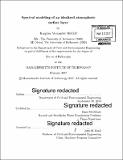Spectral modeling of an idealized atmospheric surface layer
Author(s)
McColl, Kaighin Alexander
DownloadFull printable version (10.19Mb)
Other Contributors
Massachusetts Institute of Technology. Civil and Environmental Engineering.
Advisor
Dara Entekhabi.
Terms of use
Metadata
Show full item recordAbstract
Almost all of humanity resides in the atmospheric surface layer (ASL), so its state (e.g., temperature, humidity, wind velocity) is relevant to a range of applications in human health, agriculture, and ecosystem health. However, the ASL is turbulent, and therefore characterized by complex dynamics across a wide range of spatial and temporal scales. Explicitly modelling turbulent motions in the ASL at all scales is computationally expensive and beyond current capabilities. In this thesis, a framework is proposed for parsimoniously modelling a broad range of turbulent motions in wall-bounded turbulent flows such as the ASL, using spectra of turbulent fluctuations as inputs. Turbulent spectra contain information on turbulent motions across scales, and are constrained by theory and observations. By propagating spectra through a cospectral budget, a model of the mean velocity profile (MVP) is obtained. Comparison with a direct numerical simulation (DNS) of a neutral channel flow reveals a good correspondence between the MVPs of the cospectral budget model and DNS, provided the pressure-decorrelation model in the cospectral budget includes established effects of wall-blocking. This work demonstrates that the distribution of turbulent vertical velocity fluctuations (the 'microstate' of the flow) contains sufficient information to generate the MVP (the 'macrostate' of the flow). It also establishes a link between two previously unrelated areas of the turbulence literature: 1) Kolmogorov's scaling of the turbulent energy spectrum, derived for homogeneous, isotropic turbulence and 2) the 'law of the wall' in wall-bounded turbulence. The cospectral budget model is then extended to the case where the wall-bounded flow is heated from below, as in an unstable ASL. The MVP and mean buoyancy profile (MBP) of the cospectral budget model and the DNS agree qualitatively, with remaining differences attributable to neglected terms in the cospectral budget, and the low Reynolds number of the DNS. The normalized turbulent statistics of the heated duct flow DNS agree surprisingly well with ASL measurements, despite the low Reynolds number of the DNS and other differences. Treating the DNS as an idealized ASL, a spectral model is derived to describe the partitioning of turbulent kinetic and potential energy between turbulent transport of heat and momentum in the ASL. The model reproduces observed dissimilarity between turbulent heat and momentum transport in unstable conditions. It attributes the dissimilarity to contributions from large eddies in turbulent heat transport, which are largely ignored in existing ASL parameterizations in weather and climate models.
Description
Thesis: Ph. D., Massachusetts Institute of Technology, Department of Civil and Environmental Engineering, 2017. Cataloged from PDF version of thesis. Includes bibliographical references (pages 115-126).
Date issued
2017Department
Massachusetts Institute of Technology. Department of Civil and Environmental EngineeringPublisher
Massachusetts Institute of Technology
Keywords
Civil and Environmental Engineering.